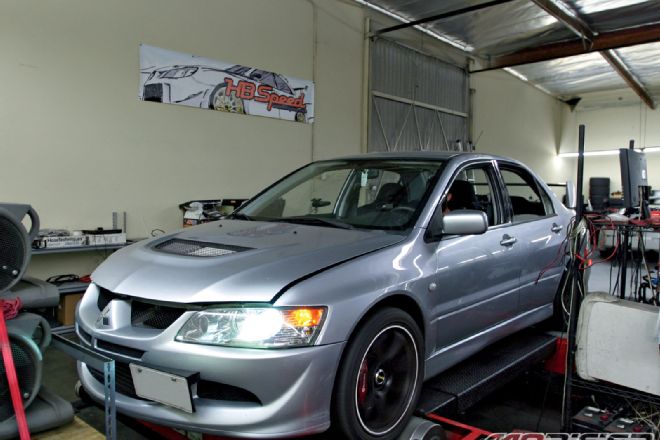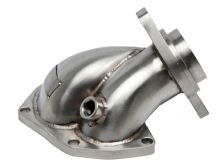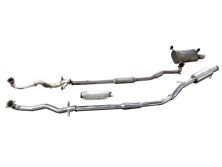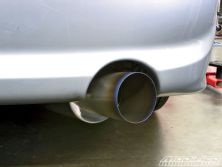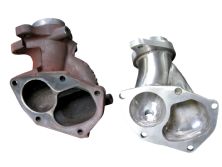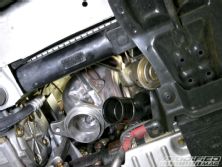Description
Finding something new, different, but relatable, to test for our monthly Proving Grounds department can be challenging. We finally decided on testing some aftermarket tubular O2 housings for factory turbocharged applications. The debate was whether something with nearly identical orifice diameters as the stock piece could actually make power. More importantly, we wanted to see if it made power for the average bolt-on guy without any tuning and running stock boost pressures. So like you, we scoured the Internet and hunted for a quality part at a reasonable price for us to test. We came upon Mach V Motorsports' online store filled with most parts you can imagine for the Mitsubishi EVO platforms and found a reasonably priced DME O2 housing for our EVO 8 test car there and placed the order for our test.
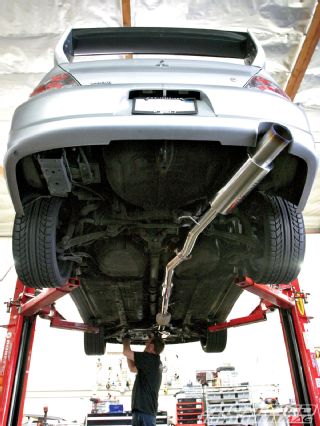 |
2003 Mitsubishi Lancer Evolution VIII - DME And Turbo XS - O2 Housing And After-Cat Exhaust And Downpipe
|
2003 Mitsubishi Lancer Evolution VIII - DME And Turbo XS - O2 Housing And After-Cat Exhaust And Downpipe
Specifications & Details
'03 Mitsubishi Lancer Evolution VIII
Engine: 2.0-liter 4G63TC
Relevant modifications: Aftermarket front-mount intercooler and intake
Key Features
• 3-inch stainless steel exhaust and downpipe tubing
• Large exhaust resonator for your driving sanity
• Straight-through muffler canister
• Tubular O2 housing with larger radius bends for improved flow
• 33+ whp gains without any tuning
But there's a problem. Nobody in their right mind would start off tuning their EVO by bolting on an O2 housing. The downstream exhaust restriction from the stock exhaust would make the part useless. So we also at least needed an exhaust and downpipe on the car before testing the O2 housing. Mach V Motorsports stepped in again and promptly shipped out another package with a Turbo XS 3-inch stainless steel exhaust and downpipe. HB Speed in Fountain Valley, California, stepped in to help with its facilities and AWD dyno. We started on the dyno with our baseline before installing the Turbo XS exhaust and downpipe. A couple pulls on the dyno, and we now have a representation of how much power this EVO 8 with exhaust and downpipe makes. To better understand how we were making this power, whether through changes in boost, A/F, ignition timing or just more airflow, we data-logged all these channels directly from the ECU during the dyno run. The same process was repeated a second time to test the actual O2 housing. We left the factory catalyst in place during all tests to best represent the gains a street car would experience.
Results
Our EVO 8 with almost 100,000 miles on the odometer put down a consistent 233 whp on HB Speed's Land and Sea chassis dynamometer. According to Jon Drenas, owner and tuner of HB Speed, 233 whp falls right in place with most other stock EVO 8s on his dyno. With the exhaust and downpipe installed, we saw a peak power gain of almost 18 whp at 7000 rpm and a torque gain of 16 ft-lbs at 3750 rpm. The increase in torque and power almost directly correlated to slight humps in the boost curve caused by the stock boost controller trying to compensate for the increased boost due to the reduced exhaust backpressure. We also saw a slight reduction in ignition timing advance, due to the increase in boost. There were concerns about how loud the Turbo XS exhaust and downpipe would be due to the straight-through muffler and single resonator, but after installation and dyno testing under load, the exhaust system turned out to be neither loud nor quiet by EVO standards. The added throttle response on the street is also very noticeable.
On inspection, there seemed to be few differences between the stock cast-iron O2 housing and the new DME tubular welded piece. Both turbine outlet and wastegate outlet diameters were about the same size. However, the housing outlet is bigger to meet up with the 3-inch downpipe. Internally, the wastegate merge orifice that combines the flow from the wastegate into the main exhaust flow seemed no bigger than stock. This could be a potential cause of boost spikes if the car was tuned to higher boost levels. But our dyno tests showed no signs of boost spikes even with a target boost pressure of 16-18 psi. Power-wise, the new O2 housing was good for another 15 whp up top while peak torque at 3750 rpm (where the stock turbo reaches its initial peak boost) decreased by 1 ft-lb. This loss came from the stock boost controller reducing the target boost pressure because it was near the stock programming's predetermined limits.
Jon feels that proper tuning and a boost solenoid restrictor that allows higher boost levels would significantly increase the marginal benefits of the DME O2 housing and Turbo XS plumbing.
With Exhaust And Downpipe
Gains Made
+ 17.9 Hp
+ 16.1 Ft-Lbs Torque
Before 233.3 whp and 241.7 ft-lbs
After 251.2 whp and 258.8 ft-lbs
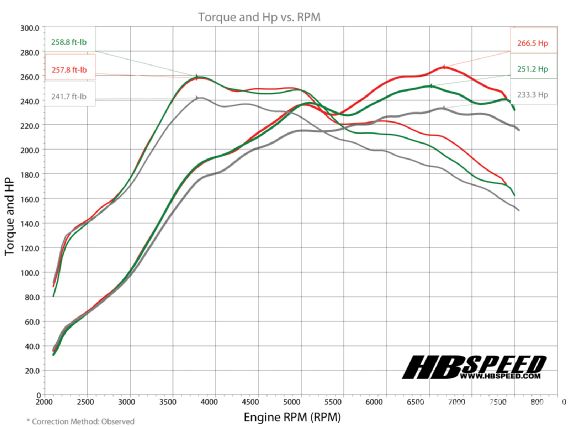 |
2003 Mitsubishi Lancer Evolution VIII - DME And Turbo XS - O2 Housing And After-Cat Exhaust And Downpipe
|
2003 Mitsubishi Lancer Evolution VIII - DME And Turbo XS - O2 Housing And After-Cat Exhaust And Downpipe
With Exhaust, Downpipe And 02 Housing
Gains Made
+ 15.3 hp
+ 1.0 ft-lbs torque
Before 251.2 whp and 258.8 ft-lbs
After 266.5 whp and 257.8 ft-lbs

